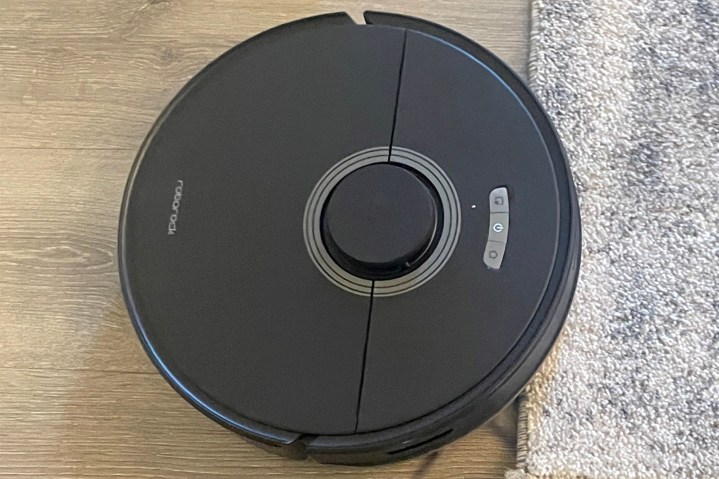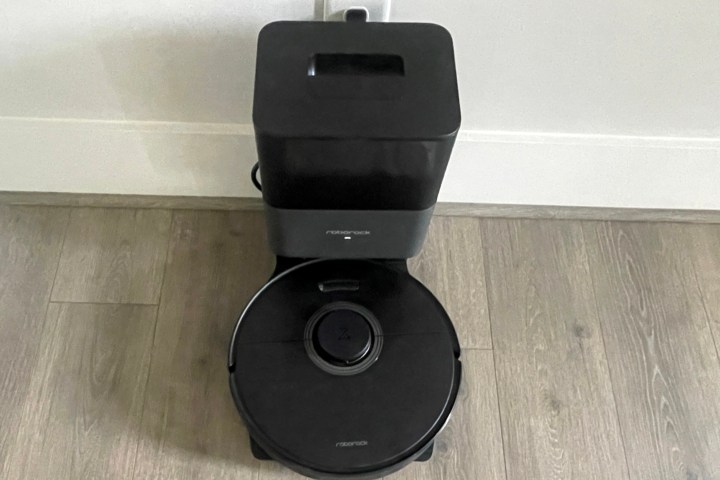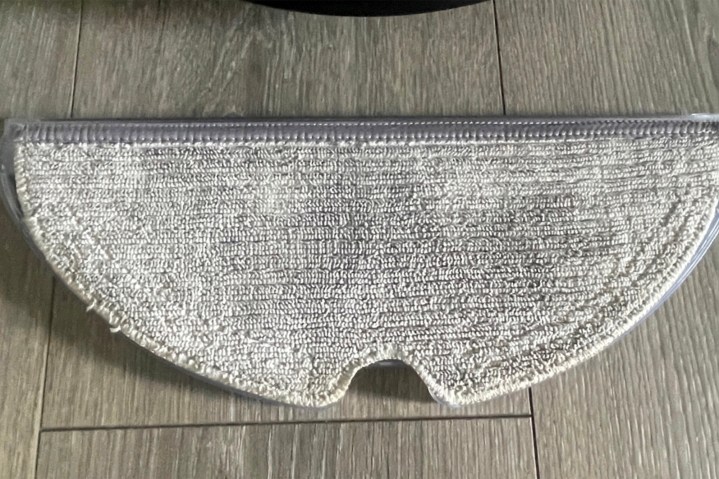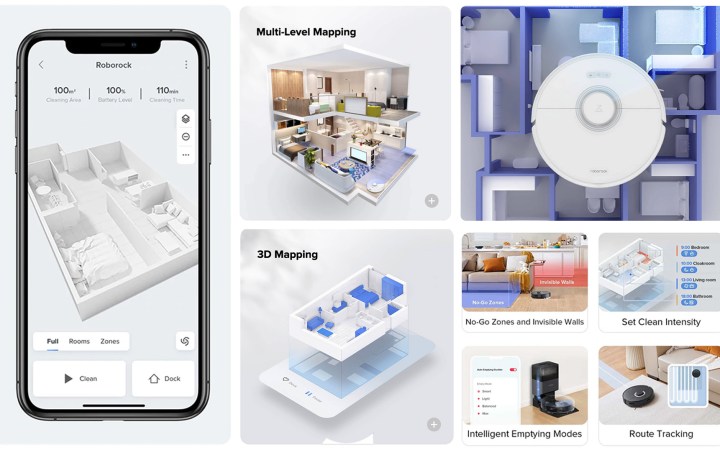Roborock Q7 Max+
MSRP $869.99
“The Roborock Q7 Max Plus is an excellent option for cleaning the home, but a few more accessories would make it an even better value.”
pros
-
Mops and vacuums simultaneously
-
Powerful 4,200 pa suction
-
Long battery life
-
Includes a self-emptying dock
-
Excellent mapping capabilities with lidar
-
No-go zones, virtual walls, and water-flow control
cons
-
Minimal accessories included
-
No sonic mopping
-
The most expensive model in the Q series
Roborock’s vacuums have come a long way in a relatively short time period. The brand recently released its Q-Series, a value robot vacuum line that offers powerful cleaning, but at a lower price range than the S7 MaxV Series. The Q-Series starts at a retail price of $430. This line includes the Q5 and Q5+, which are vacuum-only models, as well as the Q7 and Q7+, which both vacuum and mop. There are also Max versions of the Q7 and Q7+ that are more powerful than the non-Max versions, and each of the plus models come with compatible auto-emptying docks.
To see how the Q-Series compares to other robots on the market, I tested the $870 Roborock Q7 Max+ for two weeks. I was particularly impressed with its power and mapping capabilities, but I wish it came with more mopping accessories.
A clean design
 Erika Rawes/Digital Trends
Erika Rawes/Digital Trends
The Roborock Q7 Max+ comes in either black or white, so you can choose which color best matches your living space. It looks much like your standard robot vac — circular, with an eye-like protrusion on top that helps the vacuum see where it’s going. It has other sensors (cliff sensors, accelerometers, and bumpers) along the front perimeter and bottom to help prevent the Q7 Max from falling down stairs, ramming into objects, or getting stuck.
This is a high-quality unit, but it’s somewhat large and heavy. It’s almost 14 inches in diameter, about three-and-a-quarter inches tall when the wheels are not fully extended, and it weighs 8.38 pounds. I don’t have any low furniture, so its height wasn’t too much of an issue for me. However, unlike some other robots I’ve tested, the Q7 could not navigate underneath of my fridge.
When you lift the door flap on top of the robot vac, you’ll find the combined water tank (350-milliliter capacity) and dustbin (470ml capacity). On many robots I’ve tested, the water tank is located directly on top of the mop pad. The Q7 is different in that the water tank is separate from the mop pad.
The brush roller is rubberized and doesn’t have bristles, which makes it easier to clean and maintain. The rubberized brush is also better at grabbing pet hair without getting clogged. There’s one side brush, which helps to pull dirt toward the main brush.
A self-emptying robot
 Erika Rawes/Digital Trends
Erika Rawes/Digital Trends
The Q7 Max+ comes with the Auto-Empty Dock Pure feature, which means the dirt empties itself into the dock whenever the robot returns to charge. The auto-empty dock includes a dust bag, which you only have to replace about once every seven weeks. There’s also an extra dust bag included in the package, and you can purchase additional onegs from Roborock for $19. Alternatively, you can buy off-brand bags that are compatible with the dock that come as packs of six to 12 for around $20. It would be nice if Roborock included enough bags for a year, but that unfortunately isn’t the case.
Awesome suction power, lengthy battery
The Q7 Max+ has really good suction for a robot vacuum with a rating of 4200 pa (Pascal units). This is better than most robot vacuums, including many Roombas. During testing, I used the Q7 Max+ to clean my first level, which has mostly hardwood floors, but it also has a few large area rugs and a bathroom with marble tile. My floors were left without crumbs in the kitchen, and the Q7 Max+ did an excellent job of grabbing dust and hair from the edges and corners. When it traveled over area rugs, it revved up its suction with its Carpet Boost feature and left the rugs free of any dirt or debris. There were visible symmetrical vacuum lines on each of my area rugs, showing just how thoroughly it cleaned them.
The Q7 Max+ boasts a 5,200 mAh battery, and the manufacturer claims it can clean for three hours nonstop (a maximum vacuum area of 3,229 square feet). The battery made it so I never experienced a time when I ran short on power, and I was always able to clean on one continuous cycle.
Mops and vacuums
 Erika Rawes/Digital Trends
Erika Rawes/Digital Trends
The mopping function on this unit is not as advanced as the S7 MaxV Ultra’s VibraRise washing system, which scrubs floors and makes it so the vacuum system cleans its own mopping pad. The Q7 Max+ has a mopping system that’s pretty simple, but effective. It uses an electric pump to distribute and control water flow levels, allowing for 30 different water flows you can optimize to each of your floor types.
Although it doesn’t scrub like a sonic mop, it still does an exceptional job of cleaning grime from floors with its sweeper-like wet cloth, and it can mop up to 2,583 square feet at a time. This unit also vacuums and mops simultaneously, so my floors were left completely crumb-free, dust-free, and mopped all in one cleaning cycle.
Lacking in accessories
After I mopped my floors, the cleaning pad was filthy. After seeing the mop pad and learning my hardwood floors were that dirty before the mopping cycle, I started making a conscious effort to mop them more regularly (instead of just vacuuming). Sometimes with hardwood floors, you can’t see the dirt and you can only tell when your socks start showing the dirt. The problem with mopping with the Q7 Max+ on a regular basis, however, is that it only includes one cleaning pad in the package — no spare pad to use while you toss the main pad in the washing machine, and no disposable pads. The dock doesn’t clean its own mopping pad automatically like the S7 MaxV Ultra does, so having extra pads would be helpful for daily cleaning without interruptions for maintenance.
As mentioned above, the package comes with an additional dust bag for the auto-emptying dock, but it does not come with extra side brushes or any extra main brushes. You can purchase a pack of two extra mop pads from the Roborock site for $17, as well as a pack of two spare side brushes for $16. You can also find off-brand options on Amazon, where you get a larger pack of mop pads or brushes for around the same price.
3D or 2D mapping, decisive and quiet performance

The Q7 Max+ has PreciSense LiDAR Navigation, allowing it to create an accurate map of your home. It moves about the room with purpose, cleaning the edges and then the center of the room in an S-pattern. It doesn’t barge into doors, walls, or furniture, and it’s not particularly loud either.
Although I experienced some frustration with the app setup process since it wouldn’t connect via a 5 Ghz connection and it took a few tries to get the unit to connect to Wi-Fi, the app greatly enhances the Q7 Max+ overall. It can create a 2D or 3D map, and you can also switch back-and-forth between the two. There’s an abundance of features in the app, making it possible for you to include furniture, create invisible walls, prevent the robot from entering certain areas or rooms, indicate different types of flooring, and more. You can create schedules, track the maintenance on your accessories, and control a variety of other settings ranging from water flow to auto-emptying settings. You really can make this robot clean exactly where, when, and how you want it to.
Our take
The Q-Series is supposed to be more affordable, and many Roborock Q models are reasonably priced, but the Roborock Q7 Max+ still comes in at around $870. This isn’t exactly a budget price when you consider the fact that you can pick up a good budget robot vacuum for around $300 (or around $500 to $600 for a good self-emptying vac). Sure, it’s a fair price for everything it provides, but it’s not cheap.
Overall, I was impressed with its cleaning performance, battery, and app features. However, for a unit this pricey, I expected it to include more replacement accessories in the package.
Is there a better alternative?
The Q7 Max+ sits in a unique category as the most expensive vacuum in a budget series. It’s not nearly as expensive as some of the higher-end vacuums, like Roborock’s S7 MaxV Ultra or Ecovac’s Deebot X1 (which both sell for around $1,400), but it also doesn’t offer the same level of cleaning performance as the $1,500 units, especially when it comes to mopping.
If you’re looking for a robot with sonic mopping, but you don’t want to spend almost $1,500, look at the Roborock S7 MaxV Plus. It retails for a bit lower ($1,160). If you want something even more affordable, and mopping isn’t important to you at all, look at a lower-level Q-series model like the Q5 or Q5+.
How long will it last?
The Q7 Max+ is pretty close to its similarly -priced competitors (technologically speaking). It doesn’t allow for a 5Ghz Wi-Fi connection, but it offers lidar navigation, 3D mapping, and auto-emptying. With proper maintenance, this robot should last for at least a few years, and there’s no reason to think the app should discontinue support of this unit anytime soon.
Should you buy it?
yes The Roborock Q7 Max+ is a sturdy, durable robot that reliably vacuums and mops floors. It has an excellent battery, powerful suction, and an auto-emptying dock so you don’t have to do any prep work before you clean.
Editors’ Recommendations
